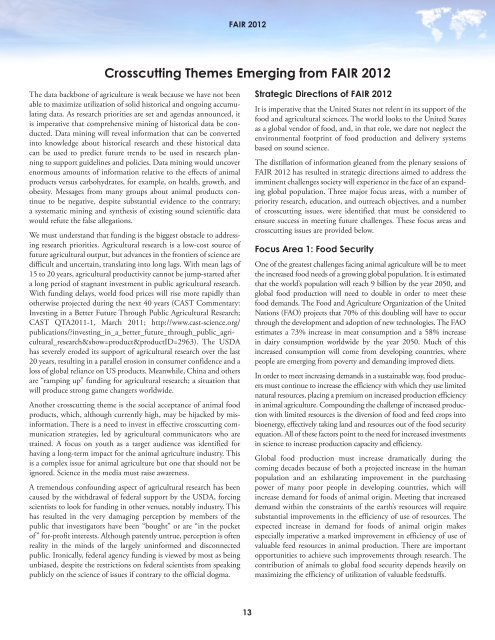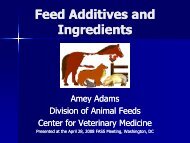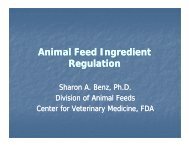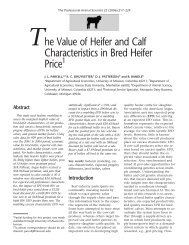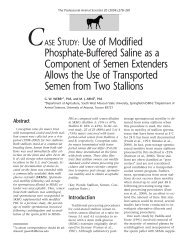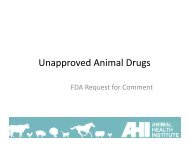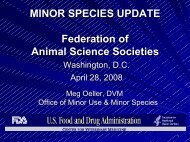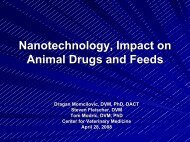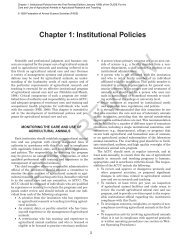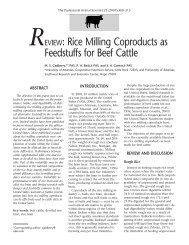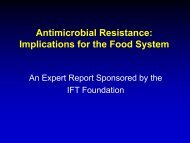outcomes document - Federation of Animal Science Societies
outcomes document - Federation of Animal Science Societies
outcomes document - Federation of Animal Science Societies
Create successful ePaper yourself
Turn your PDF publications into a flip-book with our unique Google optimized e-Paper software.
FAIR 2012Crosscutting Themes Emerging from FAIR 2012The data backbone <strong>of</strong> agriculture is weak because we have not beenable to maximize utilization <strong>of</strong> solid historical and ongoing accumulatingdata. As research priorities are set and agendas announced, itis imperative that comprehensive mining <strong>of</strong> historical data be conducted.Data mining will reveal information that can be convertedinto knowledge about historical research and these historical datacan be used to predict future trends to be used in research planningto support guidelines and policies. Data mining would uncoverenormous amounts <strong>of</strong> information relative to the effects <strong>of</strong> animalproducts versus carbohydrates, for example, on health, growth, andobesity. Messages from many groups about animal products continueto be negative, despite substantial evidence to the contrary;a systematic mining and synthesis <strong>of</strong> existing sound scientific datawould refute the false allegations.We must understand that funding is the biggest obstacle to addressingresearch priorities. Agricultural research is a low-cost source <strong>of</strong>future agricultural output, but advances in the frontiers <strong>of</strong> science aredifficult and uncertain, translating into long lags. With mean lags <strong>of</strong>15 to 20 years, agricultural productivity cannot be jump-started aftera long period <strong>of</strong> stagnant investment in public agricultural research.With funding delays, world food prices will rise more rapidly thanotherwise projected during the next 40 years (CAST Commentary:Investing in a Better Future Through Public Agricultural Research;CAST QTA2011-1, March 2011; http://www.cast-science.org/publications/?investing_in_a_better_future_through_public_agricultural_research&show=product&productID=2963).The USDAhas severely eroded its support <strong>of</strong> agricultural research over the last20 years, resulting in a parallel erosion in consumer confidence and aloss <strong>of</strong> global reliance on US products. Meanwhile, China and othersare “ramping up” funding for agricultural research; a situation thatwill produce strong game changers worldwide.Another crosscutting theme is the social acceptance <strong>of</strong> animal foodproducts, which, although currently high, may be hijacked by misinformation.There is a need to invest in effective crosscutting communicationstrategies, led by agricultural communicators who aretrained. A focus on youth as a target audience was identified forhaving a long-term impact for the animal agriculture industry. Thisis a complex issue for animal agriculture but one that should not beignored. <strong>Science</strong> in the media must raise awareness.A tremendous confounding aspect <strong>of</strong> agricultural research has beencaused by the withdrawal <strong>of</strong> federal support by the USDA, forcingscientists to look for funding in other venues, notably industry. Thishas resulted in the very damaging perception by members <strong>of</strong> thepublic that investigators have been “bought” or are “in the pocket<strong>of</strong>” for-pr<strong>of</strong>it interests. Although patently untrue, perception is <strong>of</strong>tenreality in the minds <strong>of</strong> the largely uninformed and disconnectedpublic. Ironically, federal agency funding is viewed by most as beingunbiased, despite the restrictions on federal scientists from speakingpublicly on the science <strong>of</strong> issues if contrary to the <strong>of</strong>ficial dogma.Strategic Directions <strong>of</strong> FAIR 2012It is imperative that the United States not relent in its support <strong>of</strong> thefood and agricultural sciences. The world looks to the United Statesas a global vendor <strong>of</strong> food, and, in that role, we dare not neglect theenvironmental footprint <strong>of</strong> food production and delivery systemsbased on sound science.The distillation <strong>of</strong> information gleaned from the plenary sessions <strong>of</strong>FAIR 2012 has resulted in strategic directions aimed to address theimminent challenges society will experience in the face <strong>of</strong> an expandingglobal population. Three major focus areas, with a number <strong>of</strong>priority research, education, and outreach objectives, and a number<strong>of</strong> crosscutting issues, were identified that must be considered toensure success in meeting future challenges. These focus areas andcrosscutting issues are provided below.Focus Area 1: Food SecurityOne <strong>of</strong> the greatest challenges facing animal agriculture will be to meetthe increased food needs <strong>of</strong> a growing global population. It is estimatedthat the world’s population will reach 9 billion by the year 2050, andglobal food production will need to double in order to meet thesefood demands. The Food and Agriculture Organization <strong>of</strong> the UnitedNations (FAO) projects that 70% <strong>of</strong> this doubling will have to occurthrough the development and adoption <strong>of</strong> new technologies. The FAOestimates a 73% increase in meat consumption and a 58% increasein dairy consumption worldwide by the year 2050. Much <strong>of</strong> thisincreased consumption will come from developing countries, wherepeople are emerging from poverty and demanding improved diets.In order to meet increasing demands in a sustainable way, food producersmust continue to increase the efficiency with which they use limitednatural resources, placing a premium on increased production efficiencyin animal agriculture. Compounding the challenge <strong>of</strong> increased productionwith limited resources is the diversion <strong>of</strong> food and feed crops intobioenergy, effectively taking land and resources out <strong>of</strong> the food securityequation. All <strong>of</strong> these factors point to the need for increased investmentsin science to increase production capacity and efficiency.Global food production must increase dramatically during thecoming decades because <strong>of</strong> both a projected increase in the humanpopulation and an exhilarating improvement in the purchasingpower <strong>of</strong> many poor people in developing countries, which willincrease demand for foods <strong>of</strong> animal origin. Meeting that increaseddemand within the constraints <strong>of</strong> the earth’s resources will requiresubstantial improvements in the efficiency <strong>of</strong> use <strong>of</strong> resources. Theexpected increase in demand for foods <strong>of</strong> animal origin makesespecially imperative a marked improvement in efficiency <strong>of</strong> use <strong>of</strong>valuable feed resources in animal production. There are importantopportunities to achieve such improvements through research. Thecontribution <strong>of</strong> animals to global food security depends heavily onmaximizing the efficiency <strong>of</strong> utilization <strong>of</strong> valuable feedstuffs.13


